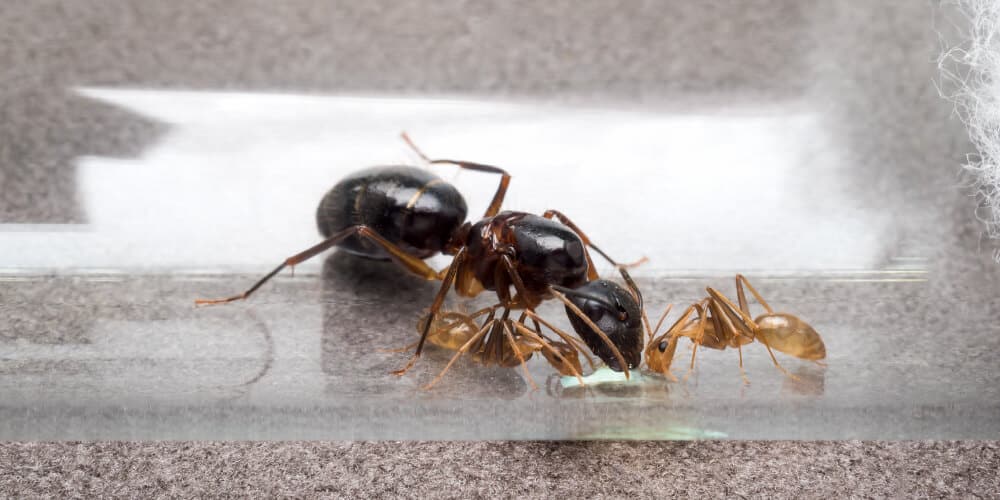
There are a few more common pests than the ant. These insects are often found in homes around the world. Whether you live in a sprawling rural town or a high-density urban city here in the US, you’ve likely spotted a trail of ants at some point in your life. You might’ve seen them crawling over the windowsill, sneaking into your sugar, or making themselves at home in your bathroom.
While ants don’t typically cause problems, severe infestations can. It’s a good idea to arm yourself with knowledge about different ant types, their behavior, and any risks associated with them.
5 Common Types of Ants in the US
Believe it or not, there are an estimated 22,000 species of ants on Earth. Of these, only 13,800 have been scientifically classified. The good news is we know quite a bit about the ants that are most common in homes across the US.
Here are some of the types of ants you should know about.
1. Odorous House Ants
Scientific name: Tapinoma sessile
These ants are small, measuring about 1/16 to 1/8 inch long. When they are crushed, they give off a rotten smell that’s almost reminiscent of coconut. This unique characteristic is how they got their name.
Odorous ants reproduce quickly. The colony’s queen can lay dozens of eggs every single day. This means a small infestation can escalate fast.
Odorous house ants generally build their nests in wall voids, under floors, and in areas of homes that have the most heat. Like many other species of ants, they are attracted to food that contains high amounts of sugar, like honey or jam.
Generally, odorous house ants are not dangerous. However, they can contaminate food, leading to wastage. They can also be tricky to eliminate entirely because of how quickly they reproduce.
Quick-fire pest control tip:
- If you spill something that contains sugar, clean it up right away. This includes juice, soda, or even coffee with flavored syrups.
2. Carpenter Ants
Scientific name: Camponotus spp.
Unlike odorous house ants, carpenter ants are large. They can grow up to a 1/2 inch in size. They have a smooth upper thorax and a heart-shaped head.
They are also different from odorous ants in that their colonies grow at a slower rate. It takes the queen several years to build up a colony of several thousands of workers.
Despite this, carpenter ants can cause damage. They don’t eat wood but hollow it out to create nesting galleries. They invade homes, seeking out moisture-damaged wood. You might see piles of sawdust-like frass around their entry points or on the ground.
Carpenter ants are not dangerous. They don’t pose a threat to human health, but they can damage the structural integrity of your home. They tunnel through wood, which weakens it over time.
Quick-fire pest control tip:
- If you spot rotting wood, replace it immediately. High levels of moisture in wood can attract carpenter ants.
3. Pavement Ants
Scientific name: Tetramorium caespitum
Pavement ants are small and dark in color, ranging from deep brown to black. They measure 1/8 inch long. Their head and thorax are marked with fine grooves that may be difficult to see.
Pavement ants get their name from their tendency to build nests under garages, sidewalks, and driveways. They forage in lines and are often seen in kitchens and bathrooms.
Colonies can number in the thousands, and they swarm in the summer to reproduce.
Pavement ants are more annoying than dangerous. They carry very little risk. However, they do move soil in and around building foundations. Over time, this could impact the strength of your home.
Quick-fire pest control tip:
- Look around the foundation of your home. Seal up any cracks that you come across.
4. Argentine Ants
Scientific name: Linepithema humile
Argentine ants are lighter in color than pavement and odorous ants. They’re often a soft brown shade. They measure between 1/16 and 1/4 inch and have a single node between their thorax and abdomen.
Like odorous ants, colonies of Argentine ants can grow quickly. A queen can lay thousands upon thousands of eggs in her lifetime, and most colonies have more than one queen. This makes them a highly invasive species. Their massive colonies often displace native ant species, too, which can negatively impact the local environment.
Because the colonies are so large, they need ample resources. This is why they tend to nest near water pipes or underneath mulch where the soil is moist. Argentine ants contaminate food and can spread bacteria. They’re also difficult to control.
Quick-fire pest control tip:
- Keep moisture levels down, especially in basements and crawl spaces.
5. Fire Ants
Scientific name: Solenopsis invicta
Fire ants are reddish-brown and 1/8 to 3/8 inch long. This species is particularly aggressive, and their stings can be painful.
Fire ants construct their nests in large mounds in areas exposed to the sun. A mature nest can house up to 250,000 ants. They reproduce rapidly, and new queens establish colonies quickly. Fire ants are also territorial and will charge as a group when their nests are disturbed.
Additionally, this type of ant is dangerous. Their stings cause intense pain and swelling, and some people may even be allergic to them.
Quick-fire pest control tip:
- If you suspect you have a fire ant mound on your property, stay away from it. Call in professional pest controllers.
6 Steps to Identify Ants in Your Home

If you found ants in your home and are not sure which type they are, you can follow this step-by-step process:
- Look at the size: Ant size varies by species. You might need to use a magnifying glass to assess whether the ants are small (like odorous house ants) or large (like carpenter ants).
- Assess the color: Fire ants, for example, are reddish, while pavement ants are typically dark brown to black.
- Consider where the nest is: Carpenter ants are likely to be near moist wood. Pavement ants often build their homes near building foundations.
- Observe their behavior: Argentine ants tend to follow long trails, while fire ants are more aggressive.
- Decide whether they have a scent: Odorous house ants are the only species that emit a distinct smell when crushed.
- Call a professional pest control company: They can accurately identify the species of ant and guide you toward a solution.
What Are the Risks of Ant Infestations?
While ants may seem like minor pests, not all species are harmless. Potential risks include:
- Health risks: Ants can contaminate food. Fire ants can cause painful stings.
- Structural damage: Carpenter ants can compromise the structural integrity of your home.
- Electrical damage: In rare cases, Argentine ants invade electrical systems and cause shorts and other problems.
- Displacement of native species: Invasive ants can overwhelm ecosystems and force native ants to go elsewhere. This can disrupt the balance of local environments.
When to Call a Professional for Ant Pest Control
Some ant problems are manageable, but others require professional pest control intervention. Here’s how to know when it’s time to call an expert.
1. The Infestation Is Persistent
If you see large numbers of ants over a longer period, it’s likely that the infestation is more extensive than you can handle alone. Ants may be nesting in hidden areas where over-the-counter solutions can’t reach.
2. Your Home Is Becoming Damaged
Carpenter ants can cause serious structural damage by digging through wood to create their nests. If you notice wood that sounds hollow when tapped or you see sawdust-like debris near wooden structures, these are signs of active carpenter ants.
3. You Have Health Concerns
Fire ants are aggressive, and their stings are unpleasant. If anyone in your home is allergic or has sensitivity to insect bites, fire ants should be handled with extreme caution. Avoid DIY remedies and instead call expert exterminators.
4. You’re Dealing with Multiple Colonies
If you’re facing an ant problem that involves multiple colonies, the infestation can spread quickly and become almost impossible to control. Different colonies may be scattered throughout your property. A professional pest control team can assess the extent of the infestation and use a fit-for-purpose treatment plan.
9 Tips for Preventing Ant Infestations
Keeping ants out of your home starts with taking a few proactive steps. Here are some simple but effective tips to help protect your home from ant infestations:
- Store food in air-tight containers.
- Clean spills and crumbs quickly.
- After meals, put the dishes in the dishwasher and wipe down surfaces. Sweep or vacuum floors regularly to remove crumbs.
- Inspect your home for any water leaks and get them fixed.
- Check your property for standing water and take steps to eliminate it.
- Walk around the perimeter of your home and look for cracks or gaps around windows, doors, and the foundation. Use caulk or weather stripping to seal them.
- Empty trash bins frequently.
- Keep shrubs, trees, and other plants trimmed so they don’t touch your house.
- Rake up fallen leaves and remove mulch near the foundation of your home.
Keep Your Home Ant-Controlled with Aptive’s Help

Don’t wait until ants become a bigger problem. Get in touch with our friendly and knowledgeable team today for professional ant pest control. Let our experts help you prevent infestations and create an environment without pests. Alternatively, you can request a quote online and reclaim your space!








